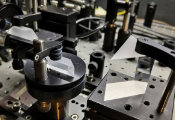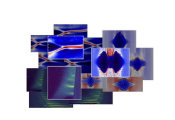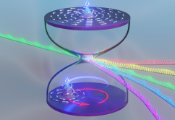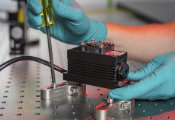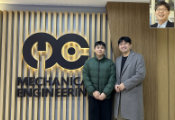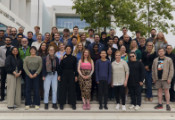Understanding the Energy Dissipation Dynamics of New Quantum Dots
July 08, 2025 - Quantum dots—tiny semiconductor nanocrystals that harness quantum mechanics to release energy as light—could lay the groundwork for better infrared cameras, television screens, and solar cells.
But scientists and engineers are still figuring out the best combinations of materials to make these quantum dots for different needs, including to emit certain colors.
In a new University of Chicago Pritzker School of Molecular Engineering (UChicago PME) study, Prof. Greg Engel, Prof. Dmitri Talapin, and their teams have designed, developed, and characterized quantum dots made of alloys of indium-gallium-phosphide. Working with collaborators at the University of California, Berkeley and Argonne National Laboratory, the team found that different combinations of alloys led to different dynamics within the dots.
The results, published in Nature Communications, could help scientists and engineers better understand how to tune quantum dots for different technologies.
“This was a true team effort among theorists and experimentalists to understand the dynamics of quantum dots and how they can be designed and developed,” said Engel, who is also a professor of chemistry.
A new alloy for tunable quantum dots
When quantum dots are illuminated with light of appropriate energy, an electron within the dot is excited to a higher energy state. When it drops back, it releases its energy as light. The color of that light depends on the energy difference between the electronic bands.
Creating quantum dots that can emit green or blue light was the goal of Aritrajit Gupta, a former graduate student in Talapin’s lab. Scientists had previously found that cadmium quantum dots could emit this light, but the lab wanted to find materials that were non-toxic and more commercially viable.
They found that combining indium-phosphide with gallium could create quantum dots that emitted blue and green light, but fundamental questions remained on how exactly this worked at the quantum level.
“We knew that when we changed the size of the quantum dots, their properties changed,” says Kailai Tommy Lin, a graduate student at UC Berkeley in the lab of Prof. Eran Rabani and co-author on the paper. “But we wondered: What if we had another knob to tune these properties? And that’s where these alloys come in.”
Understanding the electronic dynamics
Using a special process developed in Talapin’s lab, Gupta created quantum dots with different levels of gallium: one alloy had 38 percent gallium, while another had 65 percent gallium. The dots were then studied by Beiye Coco Li, a graduate student in Engel’s lab.
Using electronic spectroscopy techniques, she examined the dots’ exciton-phonon coupling, where the exciton is the fundamental unit that controls the light emission and phonon is the discrete lattice vibration. She also studied the exciton relaxation process, which is when the energy dissipates from the excited state. Both measurements are key to understanding the electronic structure of quantum dots—and how they can be tuned for commercial applications.
The lab’s spectroscopy technique can view this process down to the femtosecond, which is one quadrillionth of a second. Li found that one alloy had a longer exciton cooling time, while the other had a shorter cooling time. The length of cooling time is specific to an application—some optical technologies require shorter times, and some require longer.
“The exciton-phonon coupling and the cooling lifetimes are changing simultaneously,” Li said. “They are dependent on each other. So when we design a new quantum dot, we need to consider this.”
Lin then developed a computational model to understand the connection between the materials, the dot sizes, and what the team observed experimentally. “That helped us understand why the material compositions made a big difference in the dynamics of energy dissipation,” Lin said.
Going forward, the team will continue to study these alloys and the dynamics within the quantum dots, with the hope of improving the alloy compositions and ultimately creating a toolkit for tunable quantum dots.
“Once we can find the most viable emitters, there are a plethora of applications for quantum dots,” Gupta said.
Other authors on the paper include Ping-Jui E. Wu, Kaiyue Peng, Siddhartha Sohoni, Justin C. Ondry, Zirui Zhou, Caitlin C. Bellora, Young Jay Ryu, Stella Chariton, David J. Gosztola, Vitali B. Prakapenka, and Richard D. Schaller.


